How to Make a Mountain Bike Single Speed
A single speed mountain bike is a bike that has only one gear ratio and no derailleur or shifter. It is a simple, lightweight, and low-maintenance option for mountain biking enthusiasts who want to challenge themselves and enjoy the pure essence of riding. In this blog post, we will show you how to convert your existing mountain bike into a single speed mountain bike with a few easy steps and some basic tools.
How to Convert Your Mountain Bike into a Single Speed Bike
Converting your mountain bike into a single speed bike is not as hard as you might think. You just need a few tools and some basic skills. Here are the steps:
Step 1: Remove the Derailleur, Shifter, Cables, Housing, Cassette, and Extra Chainrings

The first step is to remove all the components that are related to the gearing system of your bike. You will need an Allen wrench, a chain tool, a cassette lockring tool, and a crank puller for this task.
#1- Remove the rear derailleur
Start by removing the rear derailleur from the frame by loosening the bolt that attaches it to the derailleur hanger with an Allen wrench. Then disconnect the cable from the derailleur by loosening the cable clamp bolt with the same wrench.
#2- Safely remove the shifter
Next, remove the shifter from the handlebar by loosening the clamp bolt with an Allen wrench. Then pull out the cable from the shifter and cut off any cable ends or ferrules with a pair of wire cutters.
#3- Remove the cable housing
Then remove the cable housing from the frame by pulling it out from the cable stops or guides. You may need to use pliers or a screwdriver to pry them out if they are tight.
#4- Remove the cassette
Next, remove the cassette from the rear wheel by using a cassette lockring tool and a chain whip. Insert the lockring tool into the splines of the lockring and hold it in place with an adjustable wrench. Then wrap the chain whip around one of the larger cogs and turn it counterclockwise while turning the lockring tool clockwise with the wrench. This will loosen the lockring and allow you to slide off the cassette from the freehub body.
#5- Remove the extra chainrings
Finally, remove the extra chainrings from the crankset by using an Allen wrench and a chainring bolt tool or a flathead screwdriver. Loosen each chainring bolt by holding one side with the bolt tool or screwdriver and turning the other side with the wrench. Then slide off the chainrings from the crank spider.
Step 2: Install a Single Speed Conversion Kit
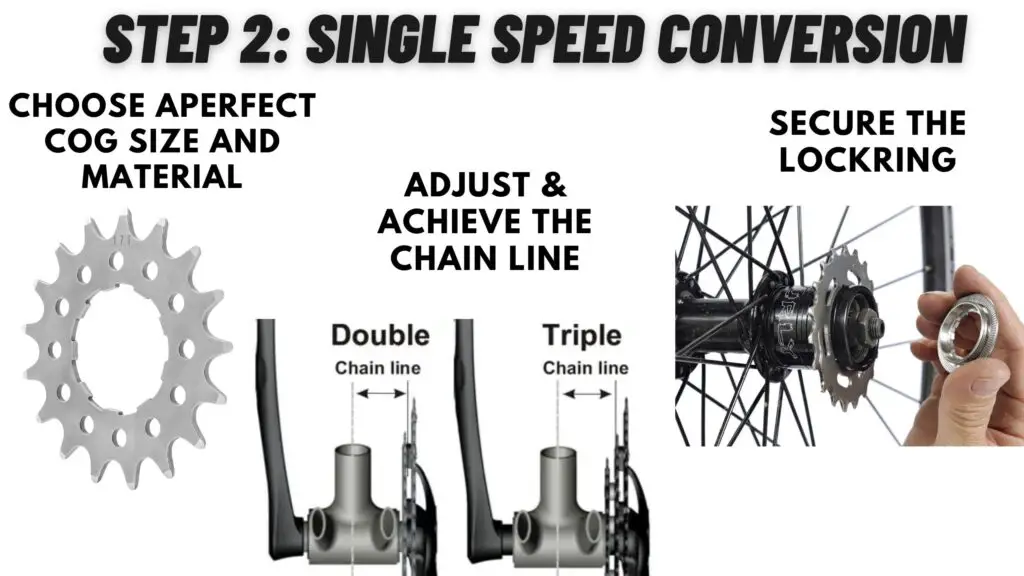
The second step is to install a single speed conversion kit on your rear wheel. A single speed mountain bike conversion kit consists of a single cog, spacers, and a lockring that fits on your existing freehub body. You will need a cassette lockring tool and a chain whip for this task.
#1- Choose a cog size and material
Start by choosing the cog size that suits your desired gear ratio. A common choice for mountain biking is 16 or 18 teeth, but you can experiment with different sizes to find what works best for you. You can also choose the cog material, either steel or aluminum. Steel cogs are more durable and cheaper, but heavier and prone to rust. Aluminum cogs are lighter and more resistant to corrosion, but more expensive and less durable.
#2- Adjust the chain line
Next, slide the cog onto the freehub body, making sure it aligns with the splines. Then add spacers on either side of the cog to adjust the chainline and fill the gap left by the cassette. The chain line is the straight line that connects the center of the chainring to the center of the cog.
#3- Achieve a perfect chain line
Ideally, you want the chain line to be as straight as possible to reduce friction and wear on the chain and drivetrain. You can use different sizes and combinations of spacers to achieve a perfect chain line. A good way to check the chain line is to use a ruler or a straight edge and measure the distance from the center of the seat tube to the center of the chainring and the cog. They should be equal or very close.
#4- Secure the lockring
Finally, secure the cog and spacers with the lockring by using a cassette lockring tool and a chain whip. Insert the lockring tool into the splines of the lockring and hold it in place with an adjustable wrench. Then wrap the chain whip around one of the smaller cogs and turn it clockwise while turning the lockring tool counterclockwise with the wrench. This will tighten the lockring and prevent the cog and spacers from moving.
Step 3: Install a Chain Tensioner

The third step is to install a chain tensioner on your frame. A chain tensioner is a device that keeps your chain tight and prevents it from falling off or skipping on the cog. You will need an Allen wrench for this task.
#1- Choose a chain tensioner
Start by choosing a chain tensioner that suits your frame type and dropout style. There are two main types of chain tensioners: spring-loaded and fixed. Spring-loaded tensioners have a spring mechanism that pushes or pulls the chain to maintain tension.
#2- Fixed chain tensioners
Fixed tensioners have a fixed position that holds the chain in place. Spring-loaded tensioners are more versatile and can work with most frames and dropouts, but they are heavier, more expensive, and more prone to failure. Fixed tensioners are lighter, cheaper, and more reliable, but they require horizontal or sliding dropouts to adjust the chain tension.
#3- Install the chain tensioner
Next, install the chain tensioner on your frame by attaching it to the derailleur hanger or dropout with an Allen wrench. Make sure it is aligned with the cog and does not interfere with other parts of your bike, such as brakes or fenders.
#4- Adjust the chain tension
Finally, adjust the chain tension by using the adjustment screws or bolts on the tensioner. You want to have enough tension to keep your chain from sagging or bouncing, but not too much that it causes excessive friction or noise. A good way to check the chain tension is to lift your rear wheel off the ground and spin it by hand. The chain should run smoothly and quietly without any slack or resistance.
Step 4: Shorten Your Chain
The fourth step is to shorten your chain to fit your single speed setup. You will need a chain tool and a pair of pliers for this task.
#1- Measure the chain length
Start by wrapping your chain around your chosen chainring and cog, making sure it goes through your chain tensioner if you have one. Then find the shortest possible length that allows you to join the ends of your chain with a master link or a pin.
#2- Cut the chain to the correct length
Next, cut your chain at that length by using a chain tool. Insert one end of your chain into the slot of the tool and align it with the pin pusher. Then turn the handle of the tool clockwise until it pushes out one of the pins from your chain link. Then remove your chain from the tool and discard the excess links.
#3- Joining the chain ends
Finally, join your chain ends with a master link or a pin by using a pair of pliers. If you are using a master link, simply insert one-half of it into each end of your chain and snap them together with pliers. If you are using a pin, insert it into one end of your chain and push it through with pliers until it reaches the other end.
Read More From Bicycle Ninjaa: Different Kinds of Exercise Bikes

Benefits of Single Speed Mountain Biking
There are many reasons why you might want to try single speed mountain biking. Here are some of the benefits:
1- Better drivetrain efficiency:
A single speed bike has less friction and drag than a geared bike, which means more power is transferred from your pedals to the rear wheel. You can accelerate faster and maintain your momentum better on a single speed bike.
2- Freedom to choose any gear ratio you want:
A single speed mountain bike allows you to customize your gear ratio according to your preference, terrain, and fitness level. You can choose a higher gear for more speed and less pedaling, or a lower gear for more torque and easier climbing. You can also experiment with different chainring and cog sizes to find the optimal combination for your riding style.
3- Reduced weight:
A single speed mountain bike has fewer parts than a geared bike, which means it weighs less and is easier to carry and maneuver. You can save up to 2 kg (4.4 lbs) by removing the derailleur, shifter, cables, housing, cassette, and extra chainrings from your bike.
4- A more reliable drivetrain:
A single speed bike has less moving parts than a geared bike, which means it is less prone to mechanical failures and malfunctions. You don’t have to worry about shifting problems, chain drops, or bent derailleurs on a single speed mountain bike. You just need to keep your chain tensioned and lubricated, and you’re good to go.
5- Longer drivetrain life:
A single speed bike has less wear and tear than a geared bike, which means it lasts longer and requires less maintenance. You don’t have to replace your chain, cassette, or chainrings as often as you would on a geared bike. A single speed cog and chainring can last up to 10 times longer than their geared counterparts.
6- A much cleaner looking bike:
A single speed bike has a sleek and minimalist appearance that appeals to many riders. It has no clutter or cables hanging from the frame, and it showcases the beauty of the bike’s geometry and design.
Tips for Single Speed Mountain Biking
Now that you have converted your mountain bike into a single speed mountain bike, you are ready to hit the trails and enjoy a new riding experience. Here are some tips to help you make the most out of it:
#1- Choose your gear ratio wisely:
Your gear ratio determines how fast or slow you can go on your single speed mountain bike, as well as how hard or easy you have to pedal. There is no perfect gear ratio for every situation, so you have to experiment with different gear ratios to find the one that suits your riding style, terrain, and fitness level.
You can use a gear calculator to compare different combinations of chainring and cog sizes and see how they affect your speed, cadence, and power output. A good rule of thumb is to choose a gear ratio that allows you to pedal comfortably on most sections of the trail but still challenges you on some climbs and descents.
#2- Learn to spin and coast:
Spinning is the technique of pedaling at a high cadence (revolutions per minute) with less force. Coasting is the technique of letting go of the pedals and letting the bike roll on its own momentum. Both techniques are useful for single speed mountain biking, as they help you conserve energy, avoid muscle fatigue, and smooth out your ride.
Spinning helps you maintain your speed and overcome small obstacles or changes in terrain. Coasting helps you relax your legs and enjoy the flow of the trail. You can practice spinning and coasting on flat or downhill sections of the trail, and gradually apply them to more challenging situations.
#3- Use your body weight and position:
Your body weight and position are important factors that affect your balance, traction, and control on a single speed mountain bike. You can use them to adjust your speed, brake, steer, and maneuver your bike without relying on gears or shifting.
For example, you can lean forward and lower your center of gravity to increase your speed and stability on descents. You can lean back and lift your front wheel to reduce your speed and avoid obstacles on ascents. Shift your weight from side to side to steer and corner your bike. You can also use your arms and legs as shock absorbers to smooth out bumps and vibrations on rough terrain.
#4- Have fun and be creative:
Single speed mountain biking is a fun and creative way to explore the trails and challenge yourself. You can discover new routes, try new tricks, or set new goals for yourself.
You can also enjoy the simplicity and beauty of riding a single speed mountain bike, as it connects you more with your bike, the trail, and yourself. Single speed mountain biking is not about being faster or better than others, but about being yourself and having fun.

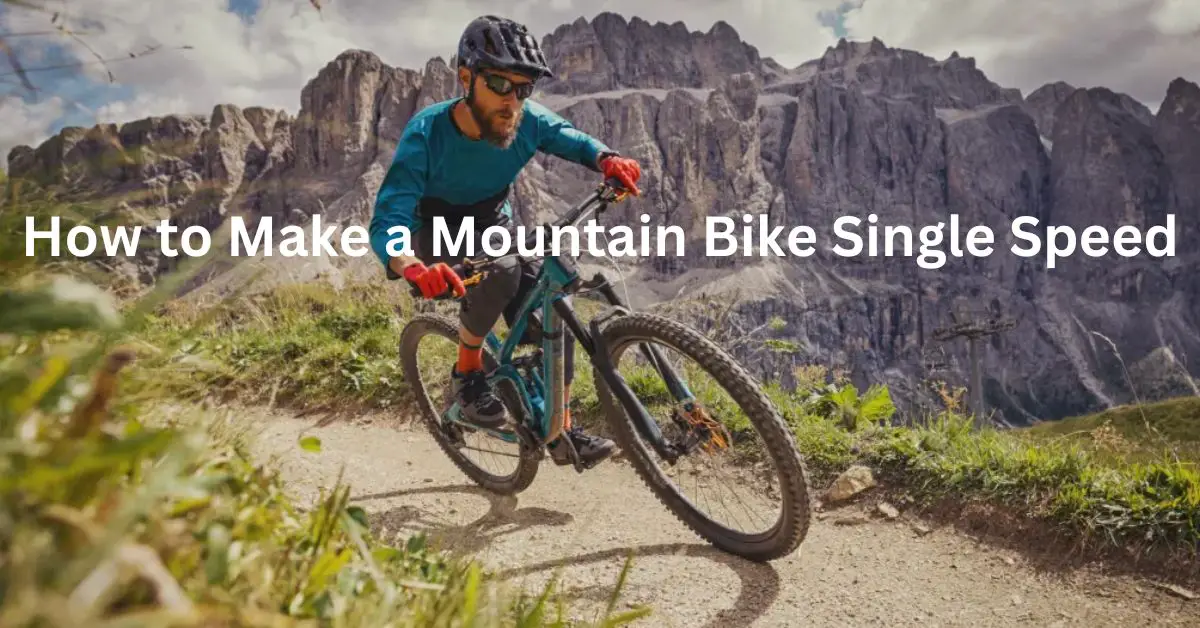


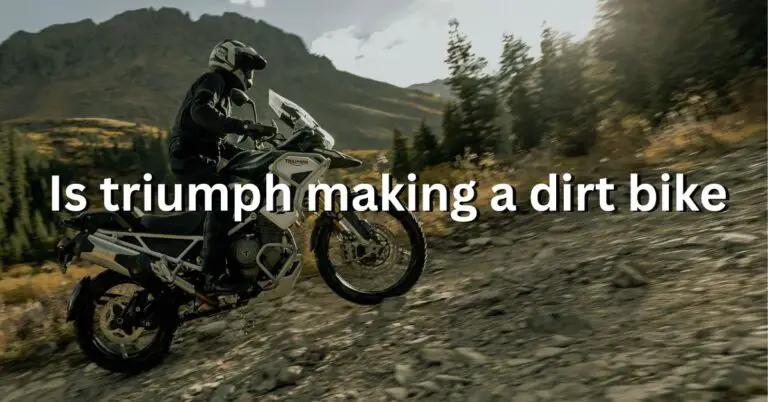

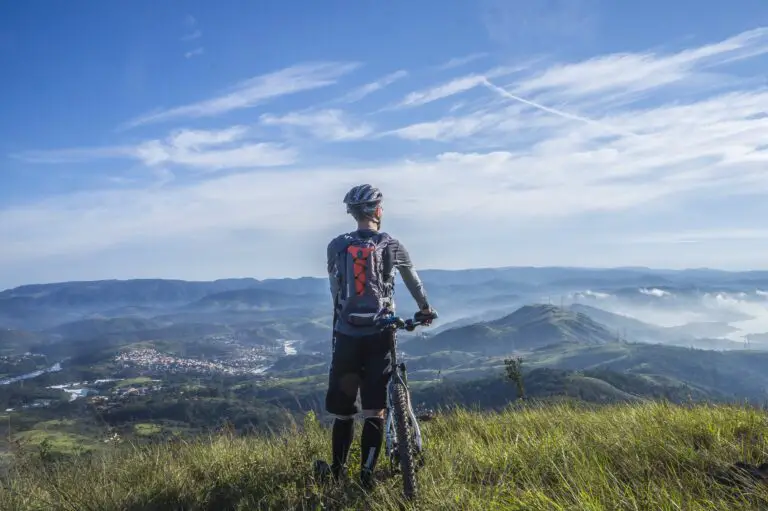
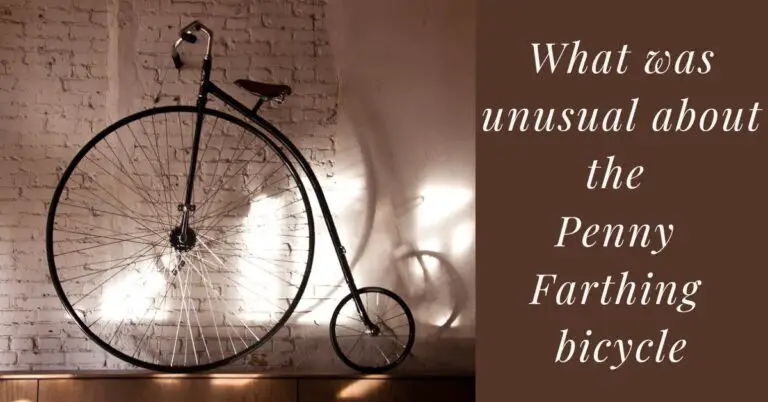
One Comment